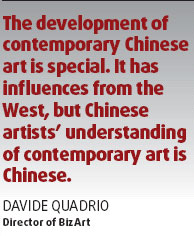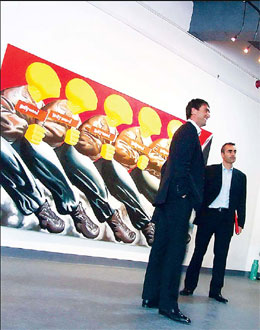Shanghai finds its SoHo
|
From left: 1.The studio Image Tunnel focuses on photography and film. Courtesy of Image Tunnel 2.The opening party at Image Tunnel. Courtesy of Image Tunnel 3.Paintings featuring China's modern history are sought-after items at M50. Jing Wei 4.An old canteen is now a conference hall at M50. Jing Wei |
There are many ways to have a stimulating Saturday in Shanghai and a stroll around the trendy art area of 50 Moganshan Road is one of them. M50, as it is known in international art circles, is located on the southern bank of Suzhou Creek, in the Putuo District.
This "creative industrial cluster park", as the Shanghai Economic Committee puts it, has some of the most active galleries in China.
But if their exhibitions are too avant-garde for your taste, you can instead watch a film at the Image Tunnel club and have a discussion with the director, or listen to a concert of Chinese music at the Bandu Rain Shelter.
You can also have coffee or listen to a lecture at Timezone 8, a bookstore that specializes in English-language titles on contemporary art.
About seven years ago the area was full of factory workshops. Today it boasts more than 100 galleries, studios, design companies and other artistic organizations.
M50 belongs to the Shanghai Chunming Roving Factory, a company which nearly went bankrupt before the artists arrived in 2000. It has survived by leasing its workshops and lofts. One of the first galleries set up in M50 was BizArt, which opened its doors in 2002.
"We chose M50 because it was cheap and the location was convenient. We need a place like this to promote contemporary art," says Davide Quadrio, director of BizArt. The 37-year-old Italian has lived in Shanghai for nearly 20 years.
A center for art of various forms, BizArt holds exhibitions, workshops and symposiums. It also has a business side providing artistic services, such as interior and graphic design.
"The development of contemporary Chinese art is special. It has influences from the West, but Chinese artists' understanding of contemporary art is Chinese," Quadrio says.
|
Galleries at Moganshan Road attract the attention of art collectors from home and abroad. Jing Wei |
"We are not a commercial gallery, which sells art works. What we do is provide opportunities for artists to express their individual views."
Quadrio says when he first moved into M50, it was a mess, but now it has become a clean and fashionable place for art enthusiasts and tourists.
"Now we have a good atmosphere at M50, as many people come for art events every day."
Image Tunnel is important to M50 not only because it is one of the oldest buildings in the area, but because its hostess, Han Yuqi, has contributed greatly to M50's preservation.
When Han rented a house in Building No 19 of M50 as a studio for her paintings in September 2002, she was told that M50 would be demolished in two years.
The area along Suzhou Creek has been a cradle of Shanghai industry and the workshops and lofts - built from the 1930s to the 1990s - reflect the industry and architecture of Shanghai's history. Many of these buildings have been demolished.
"I loved this house at first sight. For me, it has a life and memory and can give me inspiration," Han says, referring to Building No 19, which was built in 1937.
"I felt that it would be so regrettable if these houses were demolished. In Shanghai, development is so fast people often don't have time to think."
In February 2003, Han applied to the Ministry of Culture to preserve the buildings in Moganshan Road and develop the area into an art district.
She was fighting against real estate developers to keep the buildings and she never stopped filming, taking photos and surveying, even when SARS was a threat.
In July 2003, when Han and her colleagues learned three historic buildings on Moganshan Road were to be demolished, they quickly finished a feasibility report on the preservation of buildings in the area and handed it to the municipal government.
Their efforts attracted media attention and the government of Shanghai adopted their suggestions.
M50 is now an internationally known art district.
This year Han changed her personal studio into a public space called Image Tunnel, which holds various visual arts activities.
The most popular event at Image Tunnel is the film showing on Saturday. Most of these films are small productions by local directors, who discuss their ideas face-to-face with the audiences.
In addition, Image Tunnel releases a quarterly electronic magazine on its website: www.imagetunnel.com.
"We want to show the world what is happening in Shanghai," Han says.
Additionally, on most Saturday nights, there is a concert of traditional Chinese music organized by Bandu Music, at M50.
Performances are given by players from professional troupes as well as folk musicians from the countryside, hosted by Bandu's artistic director, composer Liu Xing.
The concerts at Bandu are free, but reserving a seat is a must because the venue is always packed. With a capacity of only 40, the space inspires a feeling of intimacy.
The concert venue is called Bandu Rain Shelter because it was a shelter built on waste ground, between three buildings. When the clouds open, rain can be heard falling on the roof.
"We like M50 because it is simple and natural," says Lin Xiaocao, CEO of Bandu Music, which was set up almost three years ago. "At that time this site was like a garbage dump. We cleaned it up and built a small concert hall here."

This year Bandu Music released a CD titled Flowing Water (Liu Shui), which is a selection of live recordings at the Bandu Rain Shelter.
"We enjoy the artistic atmosphere at M50. Together with other organizations we are attracting more people to M50," Lin says.
When artist Gu Wenda rented a studio in M50 four years ago, what attracted him most was the spaciousness of the loft, since many of his works are big, like the Forest of Stone Steles series, which incorporates a lot of big tombstones.
"I hope some lofts can be preserved in Shanghai. If there are only high-rises in Shanghai, it won't look like a city," Gu says.
As M50 has become an internationally-renowned art district there are no longer rooms to let.
Gu says many artists have to go to suburban areas to find spaces. It's the same story elsewhere: Artists find a cheap place, established artists and big galleries move in, rents go up, and poor artists can no longer afford to be there.
"The development of contemporary art in China is in accordance with the economic and social development of China and it is benefiting the image of the country. The specialization and management of art districts in China has improved a lot, but it is still far from mature," says Gu, who lives in the United States most of the time and owns a studio in Williamsburg, New York.
(China Daily 12/25/2007 page19)
















